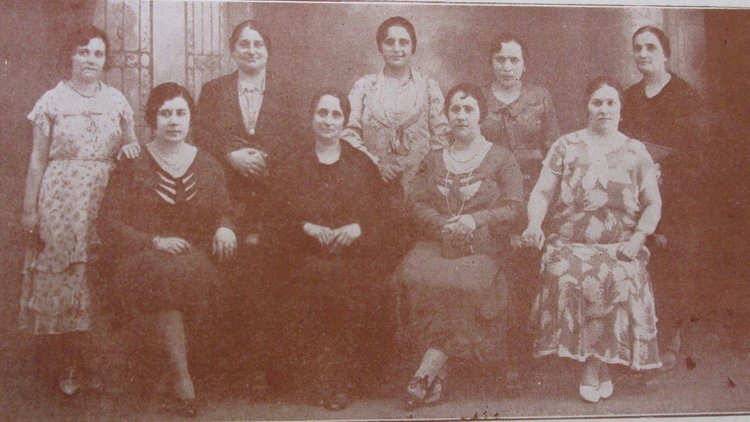Latin America & the Arab World: One Hundred Years of Migration
This post is written by Lily Balloffet, the 2015-2016 Khayrallah Center Post-Doc Fellow. Read our interview with Lily from March where she discusses her dissertation topic of Arabic speaking immigrant communities in Argentina; her ideas of identity; and different ways that Arabic speakers assimilated into South American culture. Lily received her PhD from UC Davis and countless honors for her work.

(Hemeroteca, Biblioteca Nacional, Buenos Aires)
Daily, the international press churns out coverage of what many news outlets have deemed “Europe’s Migrant Crisis.” The International Organization for Migration named the Mediterranean as the “most dangerous border crossing” region in the world. Dozens of articles, photo essays, and radio broadcasts communicate the immense human suffering that is the result of millions of displaced individuals and families in search of relief, safety, and opportunities for new beginnings. In recent months and weeks, various Latin American nations have come forward, declaring a range of “open door” policies, and proposed visa allotments. Voices from Brazil, to Chile, to Venezuela are insisting that any hope of a solution to this crisis requires a global response – not simply an overhaul of European institutions and policies. These voices are likely right – a quick review of the numbers confirms that we are indeed facing a problem that will require solutions and interventions intercontinental in scale. The United Nations High Commissioner for Refugees (UNHCR) has reported that “worldwide displacement” has grown more in a single year than ever before. Some 60 million people are currently displaced – an average of one in every 122 humans is “either a refugee, internally displaced, or seeking asylum” reported the UNHCR this past June. By the end of this year, 400,000 people are expected to cross the Mediterranean into Europe. Some organizations contend that the estimates are even higher, putting 2015 year-end projections closer to half a million. 2016 could see similar – if not even higher – numbers. The displaced people that these projected numbers represent come from many different countries: Afghanistan, Iraq, Eritrea, Congo, Somalia, Sudan, Albania, Nigeria, Syria, and others. However, Latin American politicians, newspapers, television, and social media outlets have repeatedly made public statements in regards to Syrian refugees in particular. This is surely due, in part, to the fact that Syrians constitute the largest percentage of migrants looking to make their way into Europe (and beyond.) This month, the Council on Foreign Relations estimated that Syrians fleeing that country’s civil war (which began in 2011) account for approximately 40 percent of the 400,000 plus people who have crossed into Europe via the Mediterranean (160,000 people). Afghans and Eritreans are the next largest percentages, at 11 and 7 percent, respectively – trailing the Syrian numbers by far. Nevertheless, media focus on Latin America’s role in the issue of Syrian refugees, specifically, can’t be reduced to simply a question of statistical percentages. While Syrians certainly represent a much higher percentage of the migrants, a strong majority (some 60 percent) of mobile, displaced people in the Mediterranean region come from elsewhere. If this is the case, we must ask ourselves: What other factors are at play here? As a scholar, I have spent the past five years writing about the historical relationship between Latin American and Middle Eastern nations in the twentieth century. In light of this, I must advocate for taking a moment to put the history of human movement between these two world regions into historical perspective. Here at the Khayrallah Center, one of the main goals of my Post-doctoral Fellowship in Middle East Diaspora Studies is to preserve and share knowledge about Syrian and Lebanese immigrants in Latin America. To this end, I have stitched together some historical context on immigrants from Ottoman Syria who came to Latin America beginning in the 19th century. Today, leaders such as Cristina Fernández de Kirchner (Argentina), Dilma Rousseff (Brazil), and ex-Uruguayan president José Mujica have proclaimed their intention to play an active part in helping Syrian refugees of the 21st century. I think that it is instructive to view the historical context of Syrian migration to Latin America side by side with contemporary policy initiatives. This view tells a story of two world regions who have been connected to one another for more than a century by processes of transatlantic migration.
While most people in the United States are familiar with the idea of this nation being a “country of immigrants,” many don’t realize that this term aptly describes Latin American giants such as Brazil and Argentina, as well. In 1914 more than a third of the people living in Argentina had been born elsewhere. If you were to find yourself in Argentina’s capital city, Buenos Aires, on the eve of World War I, more than half of your fellow city-dwellers were immigrants. Other major South American cities such as São Paulo, Brazil, and Montevideo, Uruguay, had similar demographics. Nineteenth-century political thinkers such as Argentina’s Juan Bautista Alberdi placed their bets on the potential benefits of large-scale European immigration to Argentina. Alberdi’s famous words “Gobernar es poblar” [“To govern is to populate”] sums up this popular philosophy that proposed filling recently independent Latin American nations with legions of immigrants to work the factory line and till the fields. Politicians and intellectuals of this mindset generally envisioned scores of Europeans swelling the ranks of their nations’ workforces – and indeed millions of (predominantly Spanish and Italian) Europeans did come. Alongside these throngs of Southern Europeans, however, came individuals from other parts of the globe: Japan, China, Southeast Asia, and thousands of people who hailed from the Syrian region of the Ottoman Empire. Exact numbers are difficult to pinpoint, but somewhere in the realm of 250-300,000 people came to Latin America’s three largest nations (Argentina, Brazil, Mexico) from the region that today comprises the territories of Syria, Lebanon, Palestine, and Jordan. Other Latin American nations such as Chile and Colombia received much smaller numbers of Syrian immigrants before WWI – with totals ranging from 5,000 to 10,000 individuals. Nations with generally low levels of immigrant arrivals logged far fewer still. In Bolivia, for example, only 86 Arabic-speaking immigrants were reported in the 1900 National Census. Upon their arrival, Arabic-speaking immigrants across Latin America realized quickly that they could not rely on Latin American governments to provide them with all of the resources they needed in order to transition smoothly into their new lives. So they turned to their community, or, in Spanish or Portuguese, their “colectividad” or “coletividade.” In the countries where Syrian and Lebanese settled in the late 19th and early 20th century – in the Americas and beyond – these immigrants began to actively cultivate a support network. Hometown clubs, mutual aid societies, intellectual circles, business bureaus, heritage associations, charity groups, and religious institutions became pillars of many Arab-Latin American communities. These organizations played diverse roles for the populations that they served. Aid societies stepped in to teach Spanish or Portuguese to newly arrived kinsmen. Generations later, many of these organizations found themselves teaching Arabic to the children and grandchildren of those first arrivals, as part of a larger effort to preserve Middle Eastern culture in the diaspora. These aid organizations were originally set up to provide not only language training, but medical care, food, small business loans, and religious services to newly arrived Arab immigrants in Latin America. At moments when Latin American states could not provide a particular service, these voluntary groups filled the gaps. In my own work, I have done research in the archives of institutions like this, such as the Club Sirio Libanés, and Hospital Sirio Libanés of Buenos Aires, and the Centro Islámico Árabe of Mendoza, Argentina.
In the 21st century, many of these organizations still exist, run by Latin American citizens – most of whom were born in Latin America, but can trace their roots back to Syria, Lebanon, or Palestine. A century or more after they were founded, many of these groups remain strongly connected to events happening thousands of miles away in the Levant. When I began my field research as a graduate student back in 2011, it was at a charity dinner held in Buenos Aires to raise money for those injured in the early days of Syria’s civil war that I made some of my earliest and most important research contacts. If we look carefully at the media coverage of Latin American responses to the Syrian refugee situation, we can see some of these historic immigrant associations still at work today. For example, in the small northeastern Argentine city of Gualeguaychu, the Centro Sirio Libanés recently announced to the national press that they had organized the necessary resources to take 8 to 10 Syrian families into their community. Some members of the Centro speak Arabic, and will be able to act as translators, and local Arab-Argentine business owners have vowed to help the new arrivals transition into the labor sector. In this way, organizations such as this one are continuing the same work that they did so many years ago as they watched tumultuous events in the Levant spur thousands of people to emigrate. There is still a long way to go before any Latin American nation takes the necessary legislative measures to admit, and provide for, a truly substantial number of refugees – Syrian or otherwise. Nevertheless, it will be interesting, in the weeks and months to come, to see what sorts of new and old extra-governmental networks of support for displaced Syrians arise in Latin American countries. As many members of these grassroots organizations have made clear, relief efforts during this migration crisis cannot depend solely on waiting for national governments to come up with solutions. I believe that as the situation progresses, we will see these community organizations find creative ways to impact the experience of new migrants who do make their way to Latin America in the months (and possibly years) to come. At this critical moment, in which people across the globe tune in to brief snapshots of immigrants’ broken paths across the oceans, borders, and other such hostile terrain, we must look ahead to possible, global, solutions to help stem the tide of the human suffering that characterizes this displacement. But this is a moment that also reminds us to look back at a long history of circulating people, resources, and ideas that originally arose in the wake of a crumbling empire. By looking back to the networks created by the hundreds of thousands of Syrians, Lebanese, and Palestinians whose journeys ended on Latin American soil, we can engage in more informed speculation as to the future networks and communities that millions of displaced Syrians will create for themselves in the days and years to come.
Sources
UNHCR Global Trends Report: World at War, June 2015: http://www.unhcr.org
Council on Foreign Relations, CFR Backgrounders: Europe’s Migration Crisis: http://www.cfr.org
NPR, The Migrant Crisis, By The Numbers, September 2015: http://www.npr.org
Samuel L. Baily & Eduardo Jose Miguez. Mass Migration to Modern Latin America (Wilmington, DE: Jaguar Books on Latin America, 2003).
Lily Balloffet, 2015. Mahjar Maps: Argentina in the Global Arab Diaspora (Unpublished Doctoral Dissertation). University of California Davis, Davis, CA.
- Categories:


